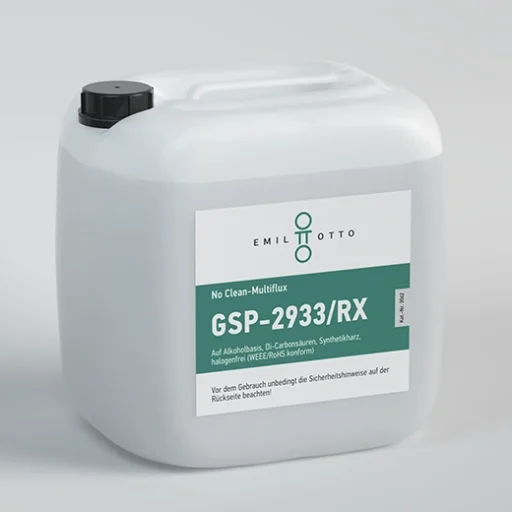Wave and selective soldering, dip soldering and strand tinning
No Clean flux based on alcohol,
Di-carboxylic acid complex, halide-free (WEEE /RoHS compliant)
Type ISO 9454: 1231 (1.2.3.A) // DIN-EN 61190-1-1 (J-STD-004): (IEC REL0)

| Appearance: | Colorless to slightly reddish, clear liquid |
| Hazardous goods: | Yes |
| Solids content: | 2.9 wt.-% |
| Acid value: | 25 - 29 mg KOH/g |
| Halogenide-free: | Yes |
| Resinous: | Yes |
| Available as a concentrate: | No |
| Density at 20 °C: | 0.79 (+/- 0.005) g/ml |
| Flash point: | 12 °C |
| Durability: | 12 months |
GSP-2933/RX is a flux of the latest generation. It is a high-performance no-clean flux based on alcohol with a di-carboxylic acid activator complex and synthetic resin. This flux was developed for selective and wave soldering processes as well as for dip soldering processes and strand tinning. It can be applied using all standard application methods (including foaming). This flux is very versatile. Good results are achieved both in wave soldering and in special applications. The generally applicable rule that applied flux quantities should always be as low as possible also applies to this product.
Spray fluxes: If dosing is possible, first set the flux quantity to 15 - 30 ml/min, observe the even flux distribution on the PCB (test with thermal paper if necessary) and then correct to the optimum quantity.
Foam fluxes: The compressor output should be uniform so that a stable and fine-pored foam head is achieved. If compressed air is supplied from the mains, a water and oil separator and at least one pressure reducer must be installed in between. An air pressure in the range of 0.6 - 0.8 bar is ideal. Fine-pored foam blocks or tubes (10-20 µm) facilitate foam fluxing. The nozzle slot should not be wider than 15 mm. Perforated support plates attached to the side promote the stability of the foam. After foam fluxing, it is recommended to blow off with air in order to distribute the flux evenly and retain excess quantities.
Density correction: The flux thinner "K-113", Cat. No. 1003, is available for this purpose.
Preheating: A preheating temperature of 80 - 110 °C is recommended for "simple" PCBs and 100 - 130 °C for "more complex" PCBs. It can be used in both leaded and lead-free solder systems.